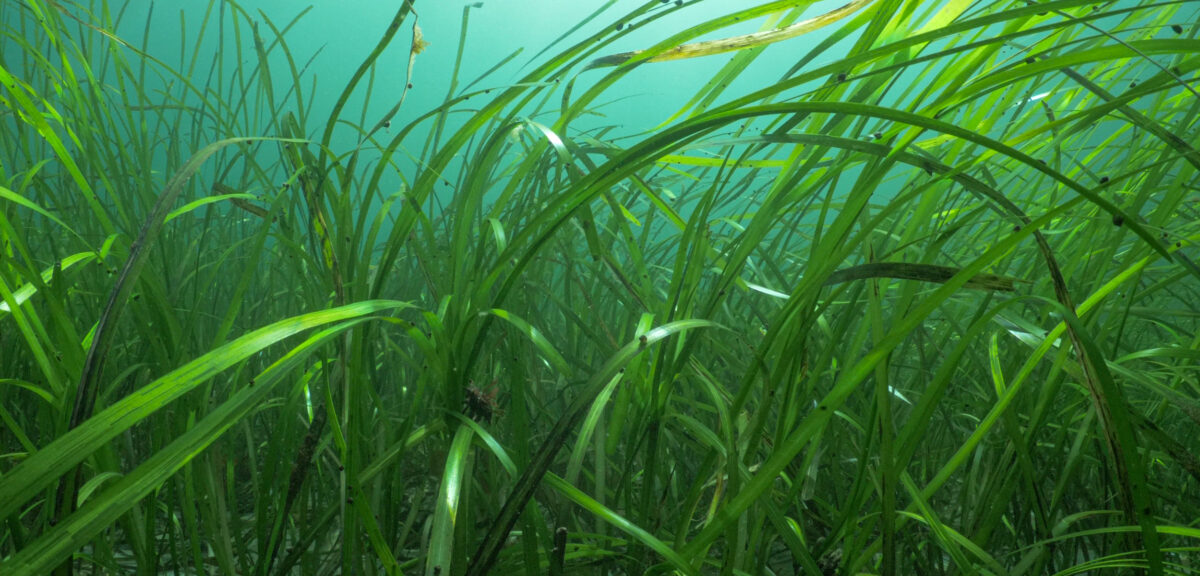Located just off the coast of every continent except Antarctica lies lush, green seagrass. In the past century, the U.S. has lost 50% of its seagrass population due to climate change and increases in sea surface temperature.
Earth and Environmental Science Professor Alyssa Novak studies the structure, function, and resilience of coastal systems. Recently, she’s been studying the effects of rising sea surface temperature on eelgrass. Eelgrass is one of the most common types of seagrass in New England, and without it, fishing economies wouldn’t be as robust and waters wouldn’t be as clear.
At first glance, one might wonder why these plants that humans don’t interact with and live in depths of 60 feet are so important. However, acres of eelgrass act as a nursery for commercially important juvenile fish species such as sea bass and cod. Eelgrass is also a carbon sink, taking carbon dioxide out of the atmosphere which helps to mitigate climate change. In addition, eelgrass stabilizes sediment loads, accumulates nutrients, and minimizes exposure of bacterial pathogens to humans, fish, and invertebrates.
Eelgrass can grow anywhere from one to six feet tall and the baffling of the leaves, moving back and forth, filters organic matter into the sediments. Leaves also prevent algal blooms by taking up nutrients such as nitrogen and phosphorus from the water. Eelgrass roots also have rhizomes that keep sediments in place and stop channels from being dredged. However, all of these benefits can only happen when eelgrass is healthy
In a paper titled Influence of Rising Water Temperature on the Temperate Seagrass Species Eelgrass (Zostera marina L.) in the Northeast USA, Novak researched how climate warming affects eelgrass growth rates, distribution shifts, patterns of sexual reproduction, and mortality. As part of a global seagrass monitoring program called SeagrassNet, Novak and her team collected seagrass density, height, percent cover, temperature, light levels, and information on the sediment substrates at eight different locations in the Northeast.
Novak and her team found that above-average summer temperatures corresponded to a decreased likelihood of eelgrass presence in the next year. However, if the temperature was roughly 0.5ºC below the average, there was a greater chance of seeing eelgrass the following year.
Sea surface temperatures are projected to rise between 3 and 4 degrees Celsius within the next 100 years. At the rate we’re heading, Novak said seagrass species extinctions are likely unless there are changes and new solutions.
To solve the issue of eelgrass decline, there have been attempts at transplanting eelgrass, but transplantation only has a 30-40% success rate. Novak said the next step is looking at different genotypes that can tolerate higher-temperature waters. However, in the end, protecting eelgrass is far easier than growing it.
Besides reducing fossil fuel emissions, Novak said working to reduce nutrient loads can consequently reduce pollution. Many factories, fertilizers, and sewage treatment plants* have runoff that finds its way into the ocean. Excess nitrogen and other nutrients cause algal blooms, reducing the amount of light that gets to the eelgrass and ultimately prevents the seagrass from photosynthesizing.
Many mooring fields also present problems for eelgrass growth: they block sunlight and propellers can also rip up eelgrass. Moving the location of mooring fields out of eelgrass beds would maintain their existence. Cape Cod Bay alone has lost 2,000 acres of eelgrass in the past 15 years, Novak said.
“We’ve already started to see the effects of eelgrass loss. There are a couple of systems that no longer have eelgrass. Since these systems don’t have that biodiversity anymore, they’re being overtaken by invasive species,” Novak said. “Those invasive species are having impacts on industries such as softshell clams.”
It’s widely known that the effects of climate change are causing the oceans to warm. What is not widely known are the individual impacts of sea surface temperature increase. Eelgrass is just one of the species affected by sea surface temperature increase and its extinction would have a huge impact on society.
“Eelgrass is one of those hidden ecosystems. Just because you don’t see it doesn’t mean it doesn’t have value,” Novak said. “It is helping us fight climate change. It’s providing a habitat for our food. It’s something that’s making our environment better and healthier. It’s something that we should be aware of and try to protect.”
*Novak recommends people reduce the amount of fertilizer they use and upgrade their septic tanks to make sure they aren’t leaking into their yards.
Sources
Plaisted HK, et al. (2022). Influence of Rising Water Temperature on the Temperate Seagrass Species Eelgrass (Zostera marina L.) in the Northeast USA. Front. Mar. Sci. 9:920699. doi: 10.3389/fmars.2022.920699


